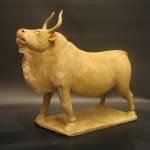Northern Qi Painted Pottery Bull, 550 CE - 577 CE
Terracotta
14.9 x 13.7
DL.2080
Further images
As implied by its short duration, the Northern Qi Dynasty was a turbulent time in the vast history of China. Locusts plagued the lands, ruining the crops. Hunger and ethnic...
As implied by its short duration, the Northern Qi Dynasty was a turbulent time in the vast history of China. Locusts plagued the lands, ruining the crops. Hunger and ethnic feuding ravaged the population. Despite this unrest the arts continued to flourish, as witnessed by this extraordinary powerful representation of a bull. The animal’s stance is assertive, with its four legs positioned firmly on the corners of the integral rectangular plinth. The head is raised, with the mouth slightly ajar, as if warning off a potential aggressor. The figurine is in excellent condition with traces of the original red polychromy in the mouth, nostrils and ears. The expertly modeled horns create a striking silhouette, contrasting with the sheer bulk of the bull’s body. There is considerable attention to detail in the modelling, especially the incised lines which add to the texture of the tail.
During this period sculptural effigies of domesticated animals were often interred in the tombs of the nobility and elite members of the social hierarchy. Created in all media, these sculptures accompanied the spirit of the deceased into the afterlife. Thus, logically, as we require food to nourish our bodies on earth, so too will we require food to nourish our souls in the afterlife. This work is more than a mere sculpture; it is a gorgeous memorial to the religious and philosophical beliefs of its time. This bull effigy has served its eternal purpose well. Today, it continues to nourish our souls with its beauty and grace.
During this period sculptural effigies of domesticated animals were often interred in the tombs of the nobility and elite members of the social hierarchy. Created in all media, these sculptures accompanied the spirit of the deceased into the afterlife. Thus, logically, as we require food to nourish our bodies on earth, so too will we require food to nourish our souls in the afterlife. This work is more than a mere sculpture; it is a gorgeous memorial to the religious and philosophical beliefs of its time. This bull effigy has served its eternal purpose well. Today, it continues to nourish our souls with its beauty and grace.





